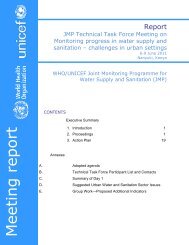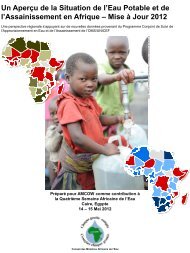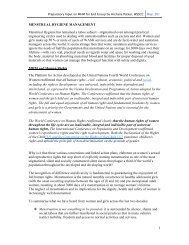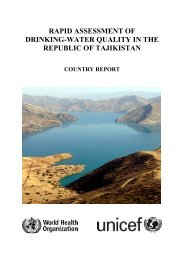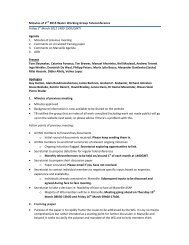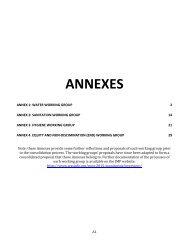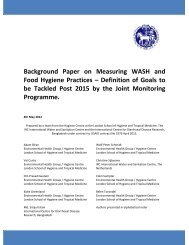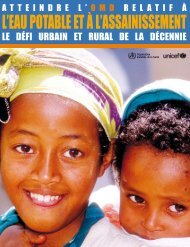Clarissa Brocklehurst - WHO/UNICEF Joint Monitoring Programme
Clarissa Brocklehurst - WHO/UNICEF Joint Monitoring Programme
Clarissa Brocklehurst - WHO/UNICEF Joint Monitoring Programme
You also want an ePaper? Increase the reach of your titles
YUMPU automatically turns print PDFs into web optimized ePapers that Google loves.
Towards a shared global monitoring <br />
framework: defining a role <br />
for Sanita7on and Water for All <br />
<strong>Clarissa</strong> <strong>Brocklehurst</strong>, Senior Advisor to SWA Secretariat <br />
Second <strong>WHO</strong>/<strong>UNICEF</strong> Consultaon on the Formulaon of <br />
Post-‐2015 WASH Goals, Targets and Indicators <br />
The Hague, December 2012
What do we monitor <br />
• Inputs – money, people, etc. <br />
• Sector processes – policy, strategy, <br />
government planning, monitoring and <br />
evaluaon <br />
• Outputs – numbers of schemes, facilies, <br />
hygiene promoon programs <br />
• Outcomes – people using improved water <br />
supplies and sanitaon facilies and praccing <br />
improved hygiene <br />
2
What levels to we want to <br />
monitor at <br />
• Subnaonal <br />
• Naonal <br />
• Regional <br />
• Global <br />
3
Sub-‐na7onal <br />
(district, province, <br />
state) <br />
Global monitoring landscape <br />
Inputs Sector Processes Outputs Outcomes <br />
Public /Donor Finance, <br />
Cost recovery (TTT), <br />
Human Resources <br />
Policy, Strategy, <br />
Planning, Budgeng, <br />
M&E <br />
Water Schemes, Sanitaon <br />
facilies, Sanitaon /<br />
Hygiene Promoon , WASH <br />
in schools and health <br />
facilies <br />
People using <br />
improved facilies <br />
and praccing <br />
hygiene <br />
Country <br />
Regional <br />
Global
Sub-‐na7onal <br />
(district, province, <br />
state) <br />
The Global monitoring landscape is crowded! <br />
Inputs Sector Processes Outputs Outcomes <br />
Public /Donor Finance, <br />
Cost recovery (TTT), <br />
Human Resources <br />
Policy, Strategy, <br />
Planning, Budgeng, <br />
M&E <br />
Water Schemes, Sanitaon <br />
facilies, Sanitaon /<br />
Hygiene Promoon , WASH <br />
in schools and health <br />
facilies <br />
Sector Informaon and <strong>Monitoring</strong> Systems <br />
People using <br />
improved facilies <br />
and praccing <br />
hygiene <br />
Some household <br />
surveys <br />
<strong>Programme</strong> and Project-‐based monitoring , waterpoint mapping <br />
Country <br />
Regional <br />
Global <br />
Sector Informaon and <strong>Monitoring</strong> Systems <br />
<strong>Joint</strong> Sector Reviews <br />
Country Status Overview (CSOs) <br />
Bo[leneck Analysis Tool (BAT) <br />
GLAAS Country Profiles <br />
Country Status Overviews (CSOs) <br />
<strong>Monitoring</strong> of E-‐Thekwini and other SANs <br />
GLAAS regional snapshots <br />
Global Analysis and Assessment of Sanitaon and Water (GLAAS) <br />
<strong>Monitoring</strong> of HLM Commitments <br />
Creditor reporng System <br />
<strong>Monitoring</strong> of WASH in <br />
schools <br />
IBNet Ulity <br />
Large Household <br />
Surveys (DHS, <br />
MICS) <br />
Census <br />
<br />
<strong>Joint</strong> <strong>Monitoring</strong> <br />
<strong>Programme</strong> (JMP)
Needed: more robust <br />
na7onal informa7on systems <br />
• These would provide informaon on WASH in each local <br />
government area for: <br />
– management decision-‐making <br />
– aggregaon up to naonal level <br />
• But -‐ li[le of exisng data can currently be aggregated <br />
further up to regional and global level <br />
6
What could be done to ra7onalise <br />
the monitoring framework <br />
1. Strengthen country-‐led naonal and <br />
subnaonal monitoring systems <br />
2. Align program and project monitoring with <br />
naonal systems <br />
3. Take advantage of emerging informaon <br />
technology <br />
4. Expand and develop the sector analysis <br />
tools (CSOs, BATs, GLAAS and others) <br />
5. Coordinate and raonalize regional and <br />
global monitoring <br />
7
What could be done to ra7onalise <br />
the monitoring framework <br />
6. Coordinate and align ming of global data <br />
collecon <br />
7. Develop a set of common standards and <br />
norms for data <br />
8. Ensure robust “feedback loops” <br />
9. Strengthen exisng systems in other <br />
sectors to provide WASH informaon <br />
10. Forge strong link between what is <br />
commi[ed at SWA High Level Meengs and <br />
what is monitored by country-‐led <br />
mechanisms. <br />
8
Needed: more robust <br />
na7onal informa7on systems <br />
• These would provide informaon on WASH in each local <br />
government area for: <br />
– management decision-‐making <br />
– aggregaon up to naonal level <br />
• But -‐ li[le of exisng data can currently be aggregated <br />
further up to regional and global level <br />
• A shared set of data standards, norms and parameters <br />
would: <br />
– Ensure countries could be confident that they were <br />
collecng data according to best pracce <br />
– Make data comparable across countries and over me <br />
– Allow data to be absorbed into regional and global <br />
monitoring systems <br />
9
A shared global monitoring <br />
framework <br />
1. A shared vision of the goals and principles of <br />
monitoring <br />
2. An inventory of the key monitoring ini7a7ves <br />
that make up the framework <br />
3. A menu of the types of monitoring <br />
4. A range of methods used for data collecon <br />
and analysis <br />
5. A set of agreed, common standards and norms <br />
for monitoring informaon <br />
6. Shared use of monitoring informa7on <br />
10
The Role of JMP and GLAAS <br />
• JMP connues to provide systemmac global <br />
tracking of sector outcomes (people served) <br />
• GLAAS aggregates data from a number of <br />
sources into an authoritave global report on <br />
sector inputs and processes that complements <br />
the JMP <br />
• GLAAS needs to be supported by a strong <br />
sector analysis tool at country level, supported <br />
by a naonal management informaon system <br />
11
What can SWA do as a <br />
Partnership <br />
• Facilitate consensus on a shared global monitoring <br />
framework across the enre sector <br />
• Increase coordinaon of monitoring between development <br />
stakeholders who are SWA partners <br />
• Support efforts to find new and improved ways to monitor <br />
challenging aspects <br />
• Support efforts to strengthen naonal and sub-‐naonal <br />
monitoring and analysis of sector bo[lenecks <br />
• Facilitate the development of a shared set of standards and <br />
norms for monitoring data <br />
• Encourage donor partners to use financial and access data <br />
to be[er target assistance <br />
• Use monitoring informaon to advocate for WASH <br />
12
Some sugges7ons from the <br />
SWA online discussions: <br />
• Ensure that monitoring <br />
includes tracking of <br />
finance, including aid <br />
effec4veness <br />
• Ensure a clear link <br />
between monitoring and <br />
commitments made at <br />
various levels <br />
• Use tools such as CSOs <br />
and BATs to “kick start” <br />
strengthening of <br />
naonal systems <br />
• Reflect that countries <br />
need to see short term <br />
improvements in <br />
monitoring, but overall <br />
meframe may be very <br />
long <br />
13
Conclusion from the Partnership <br />
Mee7ng: <br />
SWA has an important role to play in <br />
streamlining the global monitoring <br />
framework <br />
Vision: coherent naonal-‐regional-‐global <br />
monitoring system focused on the needs of <br />
countries, suitable for <br />
– decision making <br />
– aggregaon from sub-‐naonal to naonal to regional <br />
to global level <br />
14
SWA Steering CommiOee <br />
Decision: create a Task Team on <br />
Harmonizing Global <strong>Monitoring</strong> <br />
Work to long term vision – long me frame <br />
Focus on two important and inter-‐linked tasks at first <br />
1. Harmoniza7on <br />
– Start with monitoring iniaves focused on sector inputs <br />
and processes (CSO, BAT, GLAAS, GOAL WASH etc) <br />
2. Standardiza7on <br />
– Develop shared set of norms and standards for a small <br />
number of relevant parameters (“ISO Standard”) <br />
15
Thank you! <br />
16




